Cayman Islands
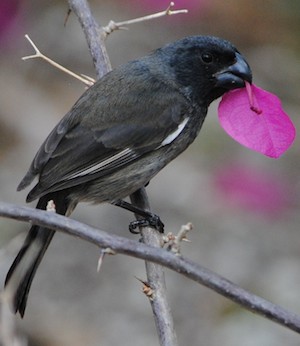
The Cayman Islands is a self-governing British Overseas Territory in the western Caribbean Sea. The 264 km2 (102-square-mile) territory comprises the three islands of Grand Cayman, Cayman Brac and Little Cayman located south of Cuba, northeast of Costa Rica, north of Panama, east of Mexico and northwest of Jamaica. Its population is approximately 75,000, and 35,000 of them live in its capital, George Town. The Cayman Islands are considered to be part of the geographic Western Caribbean Zone as well as the Greater Antilles. The territory is often considered a major world offshore financial haven for international businesses and the rich mainly due to the state charging no tax on income earned or stored. With a GDP per capita of c. US$110,000 the Cayman Islands has the highest standard of living in the Caribbean, and one of the highest in the world. Immigrants from over 140 countries and territories reside in the Cayman Islands.
The islands are in the western Caribbean Sea and are the peaks of an undersea mountain range called the Cayman Ridge. This ridge flanks the Cayman Trough, (20,000 feet deep), which lies 6 km to the south. The islands are situated about 700 km south of Miami, 750 km east of Mexico, 366 km (south of Cuba and about 500 km northwest of Jamaica Grand Cayman is by far the largest, with an area of 197 km2.
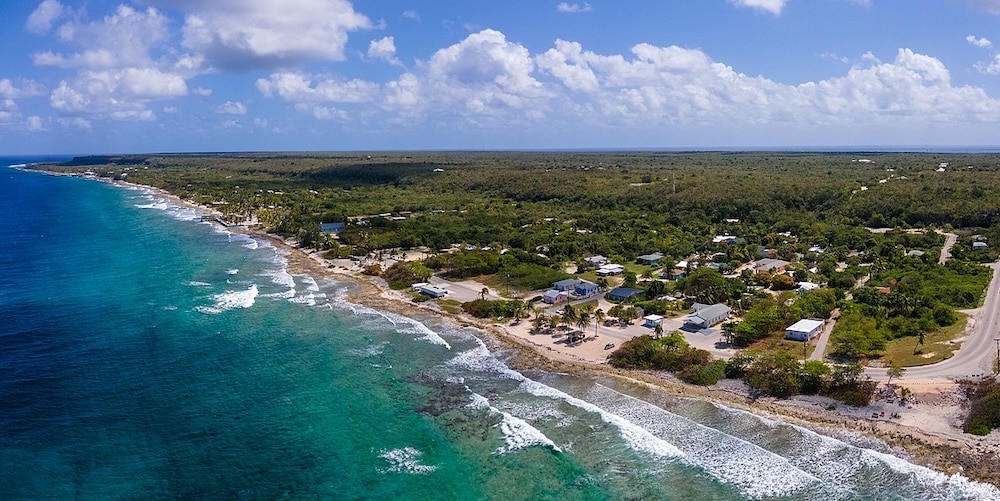
Cayman Brac – ©reezingWorld CC BY-SA 4.0 via Wikimedia Commons
Grand Cayman’s two sister islands, Cayman Brac and Little Cayman, are about 120 km east north-east of Grand Cayman and have areas of 38 and 28.5 km2 respectively. The terrain is mostly a low-lying limestone base surrounded by coral reefs. The portions of prehistoric coral reef that line the coastline and protrude from the water are referred to as ironshore. In Cayman Islands forest cover is around 53% of the total land area.
It has a tropical wet and dry climate, with a wet season from May to October, and a dry season that runs from November to April. Seasonally, there is little temperature change in the range 28 to 30 °C. A major natural hazard is the tropical cyclones that form during the Atlantic hurricane season from June to November.
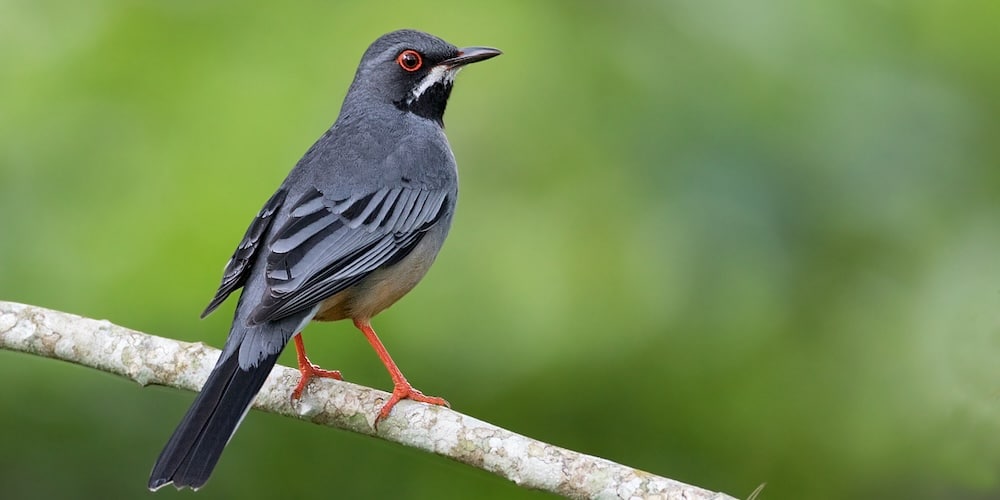
Red-legged Thrush – Turdus plumbeus – ©Dubi Shapiro
Birding the Cayman Islands
The mammalian species in the Cayman Islands include the introduced Central American agouti and eight species of bats. The Cayman Islands also possess five endemic subspecies of butterflies. These butterfly breeds can be viewed at the Queen Elizabeth II Botanic Park on the Grand Cayman. Among other notable fauna there is the critically threatened blue iguana, which is also known as the Grand Cayman Iguana Cyclura lewisi, which is endemic to Grand Cayman particularly because of rocky, sunlit, open areas near the island’s shores that are advantageous for the laying of eggs. Nevertheless, habitat destruction and invasive mammalian predators remain the primary reasons that blue iguana hatchlings do not survive naturally.
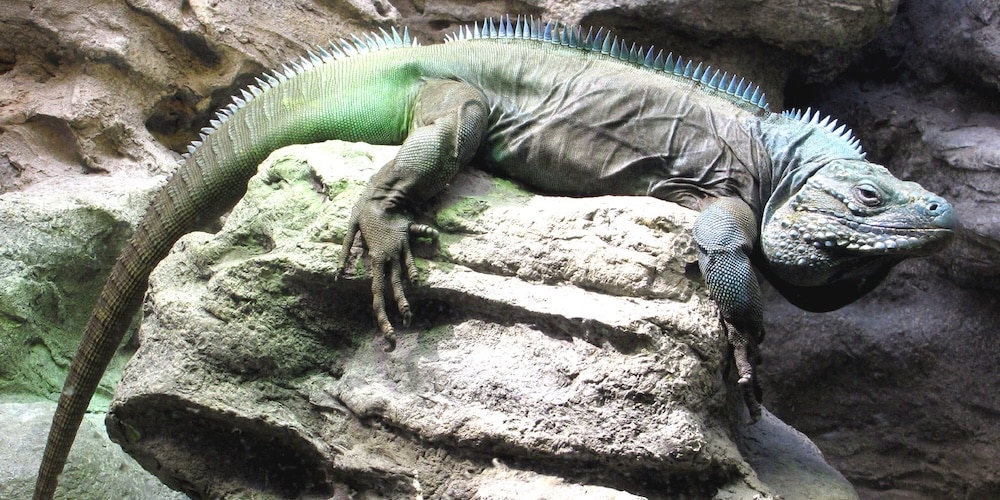
Grand Cayman Blue Iguana Cyclura lewisi -©o palsson CC BY 2.0 via Wikimedia Commons
American crocodile Crocodylus acutus is also believed to be slowly repopulating the islands from Cuba. The name ‘Cayman’ is derived from a Carib word for the various crocodilians that inhabited the islands.
Cayman avifauna includes two endemic subspecies of Amazon parrots: Amazona leucocephala hesterna or Cuban amazon, presently restricted to the island of Cayman Brac, but formerly also on Little Cayman, and Amazona leucocephala caymanensis or Grand Cayman parrot, which is native to the Cayman Islands, forested areas of Cuba, and the Isla de la Juventud. Little Cayman and Cayman Brac are also home to colonies of red-footed and brown boobies
Sightings of the peculiar variety of Cayman’s bird life depend on weather, accessibility, bird movements and the birders preference. Local species exhibit a blend of Cuban, Central American and Greater Antillean (West Indian) influence. Key local species are: Grand Cayman Amazon Parrot, West Indian Whistling Duck, La Sagra’s Flycatcher, West Indian Woodpecker, Vitelline Warbler (near endemic), Stripe-headed Tanager & the endemic Cayman Bullfinch. These should make any birdwatcher’s day!
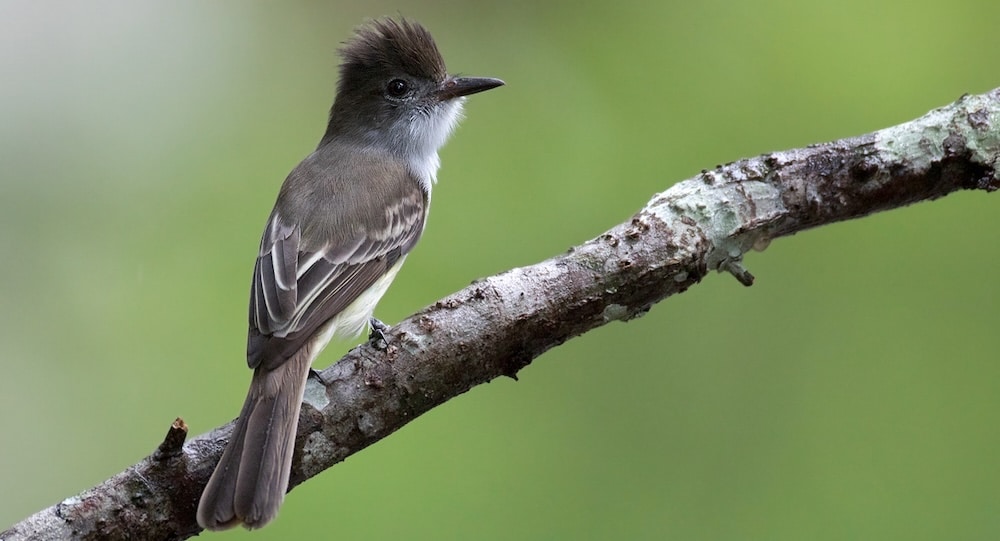
La Sagra’s Flycatcher Myiarchus sagrae – ©Dubi Shapiro
Breeding season for local species is late May through July. The vast majority of resident breeding species nest during this time frame. The local Bananaquits are an exception, appearing to nest throughout the year.
Mid to late October into November is the migratory season, coinciding with the onset of the Dry Season in the Caribbean. This is when the greatest volume of migratory species pass through the Cayman Islands. Many are from the Eastern Flyway of the North American migration routes. This is also the only time of year we have raptors on island in numbers, apart from resident Barn Owls and the occasional Screech Owl or Turkey Vulture from Cuba or Jamaica.
-
Barkers National Park
Facebook PageSatellite ViewThe Barkers peninsular is a sand spit protrusion on the North West corner of Grand Cayman. Strips of low elevation dry woodland border a combination of salt-water mangrove marshland, expanses of mud flats and numerous channels with direct access to the sea. These all produce an abundance of feed for local waterfowl, and makes this is an important stopover area for migratory birds. Numerous egrets, herons, woodpeckers, wintering ducks and warblers frequent the area. With ready access via a grid of dyke roads made by the local Mosquito Control Unit, this area is designated to be Cayman's first National Park. -
Mastic Reserve
InformationSatellite ViewApproximately 500 acres of Dry Evergreen Woodlands in the North Side district of Grand Cayman comprises the famous Mastic Reserve, one of the last stands of virgin woodland left on the island. The reserve is named for the rare, magnificent Mastic trees that can be found only in this woodland. The Mastic Reserve is a refuge for rare species of plants and wildlife. Wild Banana Orchids cloak the trees along with a variety of other epiphytes. Along with Grand Cayman Parrots, Woodpeckers, Warblers, Flycatchers and shy Caribbean Doves, miniature Tree Boas, soldier crabs, agoutis Cuban Bullfrogs, large Geckos and their smaller and more abundant cousins, the Anole lizards, are also very common. -
Meagre Bay Pond
Satellite ViewLocated just off-road immediately East of Bodden Town, Grand Cayman, Pease Bay Pond is an extension of the Central Mangrove Wetland ecosystem. This fairly shallow, 10-15 acre saltwater pond is a haven for estuarine and marine fish breeding in the surrounding mangroves. Tarpon, Mangrove Snappers, and hundreds of Mosquito Fish lurk in the murky waters. At low tide the exposed mud and shallow water attract flocks of Snowy and Great Egrets. Pied-billed Grebes, Gallinules, Coots, Ducks, Black-necked Stilts, Least Terns and even swooping Magnificent Frigatebirds also converge to take advantage of the harvest. -
Queen Elizabeth II Botanic Park
WebsiteSatellite ViewLocated less than a mile from the famous Mastic Trail in the North Side district of Grand Cayman, the 60 acre Botanic Park Reserve boasts a variety of habitats including wetland, woodland and of course flower gardens. Wild orchids and bromeliads abound in the trees. A good selection of bird life including Flycatchers, Woodpeckers, Cayman Parrots, ducks, egrets and herons can be found. The Park also houses the Grand Cayman Blue Iguana repatriation project and is the only place on the planet where this magnificent reptile can be readily seen in the wild. -
Willie Ebanks Farm
Satellite ViewLocated at the end of Hutland Road in the North Side district of Grand Cayman, farmer Mr Willie Ebanks has dedicated an area of his land abutting the Malportas Pond mangrove wetland on the North coast as a sanctuary for the endangered West Indian Whistling Duck. At this pond, within sight of both the Malportas Pond and Mr Willie`s pig pens, birders can be guaranteed to see Whistlers at any time, along with Blue-winged Teals, Coots, Grebes and the occasional Osprey or Peregrine Falcon hovering high overhead in the Winter months.
-
Number of bird species: 276
(As at March 2025)National Bird: Cayman Parrot Amazona leucocephala caymanensis
Number of endemics: 1
Grand Cayman Bullfinch Melopyrrha nigra tayloriHower, 97% of the population of Vitelline Warbler Setophaga vitellina is found here... and the only other population is a distinct race so a split is possible.
-
E-Bird
PDF ChecklistThis checklist is generated with data from eBird (ebird.org), a global database of bird sightings from birders like you. If you enjoy this checklist, please consider contributing your sightings to eBird. It is 100% free to take part, and your observations will help support birders, researchers, and conservationists worldwide. -
Wikipedia
Annotated ListThis is a list of the bird species recorded in the Cayman Islands. The avifauna of the Cayman Islands included a total of 270 species, according to Bird Checklists of the World as of May 2023.[1] Of them, 163 are rare or accidental and eight are introduced. One species (Grand Cayman thrush) was endemic to the islands but is now extinct, and one species (Jamaican oriole) has been extirpated.[2] BirdLife International has reclassified Grand Cayman's endemic Cuban bullfinch subspecies as a full species, the Grand Cayman bullfinch, but the AOS has not yet accepted this. In addition, the islands hold most of the world population of vitelline warbler which otherwise occurs only on the Swan Islands of Honduras.[2] There are 17 endemic subspecies belonging to 14 different species. -
iGoTerra Checklist
PDF ChecklistThis checklist includes all bird species found in Cayman Islands , based on the best information available at this time. It is based on a wide variety of sources that I collated over many years. I am pleased to offer these checklists as a service to birdwatchers. If you find any error, please do not hesitate to report them.
-
A Birdwatcher’s Guide to Cuba, Jamaica, Hispaniola, Puerto Rico & the Caymans
| By Guy Kirwan, Arturo Kirkconnell & Mike Flieg | Prion | 2010 | Paperback | 198 pages, Line illustrations, maps | ISBN: 9781871104127 Buy this book from NHBS.com -
A Photographic Guide to the Birds of the Cayman Islands
| By Patricia E Bradley Illustrated by Yves-Jacques Rey-Millet | Helm | Paperback | 2020 | 288 pages | colour photos | 4 b/w illustrations | 8 colour maps | ISBN: 9781472983534 Buy this book from NHBS.com -
Birds of the Cayman Islands
| By Patricia Bradley | BOC | 2000 | 250 pages, col plates | Out of Print | ISBN: 9780907446231 Buy this book from NHBS.com -
The Birds of the Cayman Islands
| By P E Bradley | BOU | 2000 | Hardback | 250 pages, Col photos | out of Print | ISBN: 9780907446231 Buy this book from NHBS.com -
The Birds of the West Indies
| By Guy M Kirwan, Anthony Levesque, Mark W Oberle & Christopher J Sharpe | Lynx Edicions | 2019 | 400 pages, 1600+ colour illustrations, 650+ colour distribution maps | ISBN: 9788416728176 Buy this book from NHBS.com

Birds of the West Indies
AndroidThis bilingual, mobile field guide for the West Indies includes all 415 bird species of Puerto Rico and the northeastern Lesser Antilles: Virgin Islands, Anguilla, Saint Martin (Sint Maarten), Antigua and Barbuda, Montserrat, Sint Eustatius, Saint Kitts and Nevis, Saint Barthélemy (St. Barts), and Saba.
Birds of the West Indies
Apple iOS |Explore the vibrant Caribbean islands with Birds of the West Indies – your pocket guide to Caribbean birdwatching!Useful Information-
Cayman Islands Birding
WebpageThe Cayman Islands is home to an array of native birds and during peak season, the islands play host to over 200 other species. Seven protected sanctuaries exist here too. On Cayman Brac, a 180-acre parrot reserve allows you a glimpse of the endangered Brac Parrot. Others commonly spotted are Tricoloured Herons, Common Moorhen, Green Herons, Black-Necked Stilts, American Coots, Blue-winged Teal, Cattle Egrets and rare West Indian Whistling Ducks.
Organisations-
Cayman Birding
Facebook PageConnecting people with nature. Providing a community for birders. Promoting the conservation -
National Trust for the Cayman Islands
WebsiteThe National Trust for the Cayman Islands Law of 1987 created this non-profit, statutory body which is responsible for the preservation of Cayman`s historic, natural and maritime heritage; the conservation of lands, natural features and submarine areas of beauty, historic or environmental importance, and the protection of our native flora and fauna.
Reserves-
Blue Iguana Conservation Facility
FacebookSatellite ViewAlmost 200 acres of government-owned prime dry shrubland habitat in the east interior of the Grand Cayman is being protected, to provide an area for restoration of the Grand Cayman Blue Iguana, Cyclura lewisi. -
NT Booby Pond Nature Reserve
WebpageSatellite ViewLITTLE CAYMAN, BWI - Last year, one of the Cayman Islands most important wildlife habitats, the Booby Pond Nature Reserve on Little Cayman, moved closer to achieving permanent protection from development when two-thirds of the area came under ownership by the National Trust for the Cayman Islands. National Trust ownership insures the area cannot be disturbed or threatened by commercial development as Little Cayman grows. -
NT Cayman Brac Parrot Reserve
Trip AdvisorSatellite ViewEstablished in 1990, the 180 acre National Trust Brac Parrot Reserve protects the nesting area of the endemic, endangered Cayman Brac parrot, Amazona leucocephala hesterna. The latest census estimates about 400 of these lovely, iridescent emerald green parrots on the Brac. This endangered subspecies of the Cuban Amazon parrot nests here from February through May but can be seen, not only atop the Bluff but also in the lowlands, especially around Stake Bay. -
NT Central Mangrove Wetland
WebpageSatellite ViewApproximately 1,500 acres of the Central Mangrove Wetland is protected through the Marine Parks Law, forming part of the Environmental Zone which has been in effect for Little Sound and its fringing mangroves since 1986. Efforts are now underway to increase the area of the Wetland under protection, through conservation land purchase. The Trust has, to date, purchased 765 acres as part of its Central Mangrove Wetland Reserve… -
NT Mastic Reserve & Trail
InformationSatellite ViewThe Mastic Reserve on Grand Cayman protects part of the largest contiguous area of untouched, old growth dry forest remaining on the island. This area and other similar expanses of forest in Cayman are of international significance representing some of the last remaining examples of the Caribbean`s dry, subtropical, semi deciduous dry forest, which have been the target of particularly intense deforestation throughout the West Indies. The area is home to a wide variety of animals and plants unique to the Cayman Islands, and also to large populations of trees which have vanished from more accessible places through logging in the eighteenth and nineteenth centuries. -
NT Queen Elizabeth II Botanic Park
WebsiteSatellite View…Orchids and bromeliads thrive near a pool fed by buttonwood swamp and Bullthatch bend is a majestically wooded area. Red Birch trees, along with local fruit trees, provide a habitat for the Grand Cayman parrot in Parrot's Paradise. Other birds commonly sighted are Vitelline Warblers, Zenaida Doves and Bananaquit, while a variety of anole lizards, tree frogs and harmless snakes can also be seen… -
NT Salina Reserve
InformationSatellite ViewThe "Salina" is the traditional place name for a large fresh water wetland in the southern part of the Reserve…
Sightings, News & Forums-
eBird
SightingseBirding This Month
Guides & Tour Operators-
Silver Thatch Excursions
Local Tour GuideGeddes Hislop Taking a view of the island from Off the Beaten Track with a qualified and experienced biologist interpretive guide.
Trip Reports-
2016 [01 January] - Håkan Thorstensson
PDF ReportThis report covers a fortnight trip to Cuba which also included a brief visit to Grand Cayman. -
2016 [07 July] - Peter Shepherd
PDF ReportThe boat stopped at Grand Cayman so I decided to make the most of the stop to go for the endemics and endemic subspecies... -
2016 [07 July] - Petri Hottola
PDF Report...The plan was to look for the near-endemic Vitelline Warbler in a promising spot next to the airport... -
2017 [06 June] - Clive Green
PDF Report. There were three life birds I was after :- Yucatan Vireo, Vitelline Warbler and Cuban Bullfinch. In addition, there were 16 local subspecies that would be new, and my only miss was the race of Barn Owl present on the Caymans. -
2018 [02 February] - Derek Lovitch
ReportWe arrived around lunchtime on the 23rd, and were immediately greeted by the endemic subspecies of Greater Antillean Grackle, as well as Northern Mockingbirds and Smooth-billed Anis.
Places to Stay-
Morritt's
AccommodationBird Watching in Grand Cayman -
Turtle Nest Inn
AccommodationWith a strong commitment to conservation and environmental protection, the Cayman Islands are a popular choice for bird watchers
Fatbirder - linking birders worldwide...
Skip to content
